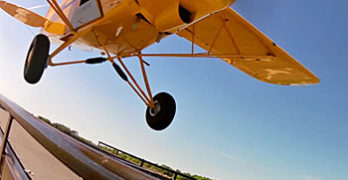HYPOTHETICAL SCENARIO — You crash landed your airplane at an airport. You are unconscious inside. Emergency crews race to assist but they are worried about your airplane having a powerful rocket motor that might injure them as they try to extricate you. What do you do? More advisably, what should you have already done?
Plenty of smart aviators and nearly every salesperson will tell you safety doesn’t sell. Pilots buy performance, range, sleek lines, comfort, and the latest instrumentation. Most take for granted that the aircraft is well-built and designed with stable characteristics and reliable systems. No matter their ultimate value, safety systems simply aren’t sexy.
Tell that to Cirrus Design, the Minnesota startup (back in the late ’90s) that did a terrific job of selling “that airplane with the parachute.” Of course, their SR20 and SR22 also steadily acquired all the dazzling features they could incorporate but any Cirrus rep’ is likely to agree the whole airframe parachute system, now called CAPS, was a leading reason why they did so well.
Search Results for : MG 21
Not finding exactly what you expected? Try our advanced search option.
Select a manufacturer to go straight to all our content about that manufacturer.
Select an aircraft model to go straight to all our content about that model.
Mainstream Media Awakens to Flying Cars
Perhaps like many of you, I read the newspaper most mornings. Today I was reading the Wall Street Journal. In one of their special sections was an article about flying cars. As regular readers know, I try to keep up with this niche within our niche of aviation.
Major publication reporters are finally catching up with what we have been observing for several years. People talk about the “mainstream media” disdainfully for a reason. Even though they provide the “news,” their realization of all things new is not necessarily that timely. So much is happening in so many fields that mainstream media reporters cannot be expected to keep up with all developments. A website like this one is laser-focused on Light-Sport Aircraft, light kit aircraft, and ultralights. Even a billion-dollar news organization can’t stay up on the latest like we can.
In fact, today’s “Journal Report” — a subsection of the daily newspaper — was all about aviation.
Toyota May Be Thinking Differently about Aerocars
Maybe you haven’t heard enough about electric-powered aircraft, flying cars, and automobiles on autopilot (presuming you’re aware of Tesla’s fatal accident in May). How about a shape-shifting aerocar? Huh?! I know it sounds rather crazy but Toyota, being the world’s largest car manufacturer, is not a name to be dismissed when they may choose to delve into the flying car business… twice, in a few months!
Nope, I’m not kidding. The Japanese car company was awarded a patent for a “Shape Morphing Fuselage for an Aerocar.” The illustrations — typical patent artwork — might fool you. This is not some 1930s silliness. The U.S. Patent office published this very recently, on June 23rd, 2016.
Perhaps it’s no more than a publicity generator, much like Amazon’s drone delivery aircraft — about which, by the way, Amazon claims to be sincere. Or, maybe Toyota is afraid Terrafugia might beat them to an interesting market, something like Tesla did to the big boys of auto manufacturing.
Jabiru Gets an “OK” from Australian CASA
It doesn’t often happen this way. When media reporters get hold of a story that casts a company or person in a bad light, this generates headlines. The results can be disastrous for that company or person. However, if the initial article turns out to be overstated, a followup report does not always earn publication. News organizations don’t gain subscribers or advertisers by saying, “All is OK now.”
Perhaps this was the situation with Jabiru… the engine side of the house, not the airframe side. As you can read in our earlier report, Jabiru was taken to task for some problems down under. You should judge for yourself.
“I hope people who read [CASA’s] report get the main message that well-maintained Jabiru engines were not a problem but sloppy maintenance did them in,” wrote Jabiru North America boss, Pete Krotje. “CASA does not mention the group of eight flight schools where most of the problems arose and that the same maintenance company did their maintenance.” He ventured further saying, “I can’t imagine that the FAA would take steps similar to CASA’s limitations without knowing the source of the problem.”
Pete wrote, “Limitations have been lifted on engines that have been maintained according to the Jabiru manual and have complied to the ‘significant’ Jabiru service bulletins & service letters.” He expressed that, “It is a real round about way of saying that poor maintenance practices are the real cause of Jabiru engine malfunctions.” Like it or not, aircraft — like houses, autos, RVs, boats, well… pretty much everything — require regular and proper maintenance.
Summertime Float Flying: Now You Can Afford It
It’s summer. It’s hot. The water beckons. Yet, you’re a pilot. How do you enjoy both? Get a seaplane, preferably a Light-Sport or light kit seaplane. You have several choices. The trouble is that any seaplane is priced well above landplanes of similar configuration. Some LSA seaplanes smash through the $200,000 barrier. That may represent a fair value for what you get but it exceeds the budget of many recreational pilots. How about $55,000 to $65,000? That sounds better, doesn’t it?
Runway testing and cross country trials of the float-equipped Merlin PSA is complete. Aeromarine LSA owner Chip Erwin reports performing stalls, turns, climb, and cruise tests, each of which passed his criteria, although he continues in trials. The floatplane Merlin has not yet entered the water but that will happen in days after Chip finishes his initial wringing out of the float version. These floats are amphibious so land trials made sense at first.
Flying Car Racing Event & Terrafugia New Weight
If my title confuses you, regrets. The two are related in my mind but not in present-day fact. Nonetheless, I found both interesting and hope you do, too.
First, the fact. Terrafugia, of current Transition Roadable Airplane or flying car fame, won a weight exemption up to 1,800 pounds. This blows past the 1,680 pound exemption won by Icon Aircraft for their A5 LSA seaplane (only 1,510 pounds of which they chose to use). Earlier Terrafugia was granted an exemption to the seaplane LSA weight of 1,430 pounds but that didn’t prove to be enough.
A problem, perhaps the major problem, for Terrafugia is contained in the Federal Motor Vehicle Safety Standards (and let’s be just as government as we can be to go with the inescapable abbreviation of FMVSS). You cannot take to the air with any airplane heavier than an ultralight vehicle (254 pounds empty plus certain exceptions) without satisfying lengthy FAA regulations and you cannot put a non-kit car on the road without meeting the considerable requirements of FMVSS.
LSA “Market Failing” Statement and My Response
This month, I had an email exchange with a leader in aviation. I debated if I should reply. For a time, I did not but I felt compelled given the person’s stature. I was driven to attempt informing those this individual might influence. I further pondered if I should write an article about it, but I feel one must confront potential errors if for no other reason than to promote healthy dialogue.
I am not to going reveal with whom I had this exchange. Personality isn’t important to the discussion but this person expressed what I suspect represents the opinion of a fair share of general aviation pilots, at least those who have not fully explored recreational aircraft such as LSA, or light kits, or ultralights.
The following comes from our second round of email. In the first, the writer referred to LSA “market failings” and I asked what was meant.
“Two Engine” SkyRunner Wins Special LSA Status
Please again welcome Powered Sport Flying publisher, Roy Beisswenger, who sent the following story on the exciting new powered parachute from SkyRunner. —DJ
I have been actively following SkyRunner for more than a year. The U.S. start-up company is rare in the Light-Sport world. The company’s MK 3.2 entry is the first American two-seat powered parachute manufacturer to launch since the LSA regulation was issued.
Sadly, the SP/LSA rules actually ran most of the powered parachute manufacturers, dealers, instructors, and even pilots from the early 2000s out of the business and sport. It is refreshing to watch a company buck that trend!
Creating a powered parachute from the ground up is a challenge, and to build one that doubles as mighty gnarly all-terrain vehicle is even more of a challenge. SkyRunner’s team did it more than once. They began their effort with a single-place model (photo) that owner and developer Stewart Hamel initially funded.
Greg Koontz’s Crazy Flying Act in Titan Legend
Probably you’ve seen an act like this before. A crazy-acting farmer or a supposed drunk hops into a Piper Cub or similar aircraft after the regular pilot leaves it unattended for a few minutes. The crazy guy has no flying experience but somehow proceeds to start up the airplane and to take off in the most out-of-control manner imaginable. As he erratically careens around the sky, handling the aircraft wickedly out of control, he nearly impacts the ground over and over. The entire act takes place within a couple hundred feet of a hard-as-concrete surface.
Even though it’s only an act and even if the pilot is actually a gifted aviator, it’s easy to get caught up in the moment and fear that nutjob is going to whack the airplane into the ground right in front of the airshow crowd watching in fascination.
So, you may look at the act Greg Koontz performs and you might undervalue the skill involved.
Jabiru 170D Returns, Offering Excellent Value
Given that the Sport Pilot / Light-Sport Aircraft sector is only a dozen years old (announced July 2004 with the first Special LSA approval in April 2005), Jabiru North America seems almost an old timer with 17 years of business in their corporate logbook. During those years, the onetime Wisconsin company relocated to Shelbyville, Tennessee.
At Sun ‘n Fun 2016, Jabiru North America announced their new J-170D model.
Australia’s most popular LSA trainer has been noticeably improved and updated. Among other improvements, the down-under engineers redesigned the vertical stabilizer, giving it a more swept stance and a wider airfoil shape, which makes the aircraft more stable and require less rudder input than before, according to Jabiru. They believe this enhanced two seater will make an even better flight instruction airplane.
“The [previous] J170-SP has been a great trainer here in the USA, with its stout landing gear, stable handling, and fuel economy of less than 4 gallons per hour in daily use,” said Pete Krotje, President of Jabiru North America.
- « Previous Page
- 1
- …
- 51
- 52
- 53
- 54
- 55
- …
- 94
- Next Page »











